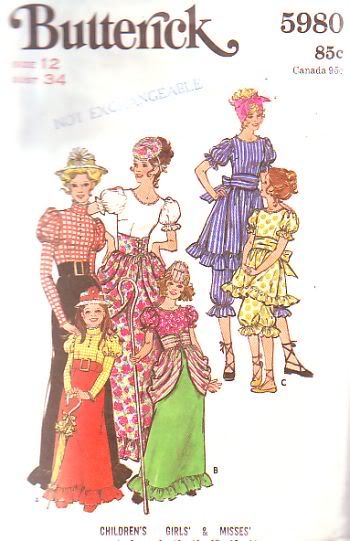The reality, though, is that most costumes are built around a few very basic shapes. It's just not necessary to reinvent the wheel.
That said, most commercial sewing patterns need a fair bit of "tweeking" to work for dance patterns.
Size:
Because they need to stay put, dance costumes are built very close to the body. Street clothes (and most commercial sewing patterns) are made to have about 2 inches of ease through the torso, sometimes more. Generally a ballet costume will only carry about a half an inch of ease.
If you're working with a multi sized pattern, this is an easy fix. I will usually trace off a pattern one size down from what the measurement chart calls for and that gets me pretty close to the correct size.
Style:
Look for basic shapes that you can use over and over, and patterns that will "multi-task" well.
This dress can be used short sleeve, long sleeved, sleeveless. The skirt can be made narrow or full, with or without panniers and with or without a sash. The panniers can be made separately to go with other costumes and the lace up belt can be made on is own as well as the bloomers. Lengthened and embellished a little, the 'c' view would make a beautiful party girl dress for the Nutcracker. Made with the lace up belt and an apron, it would make a sweet villager.
Sources:
I find that vintage patterns are the easiest to costume from as they were designed to fit closer to the body than more current patterns are. I find them at thrift shops, yard sales and online at websites like http://www.cemetarian.com/. (My personal favorite.)
Companies like Jolies and Kwik Sew have some great stretch patterns available for costumes, leotards, unitards, etc. Don't be afraid of stretch fabrics. They aren't as difficult as you think they are, I promise!
If you're just starting your pattern collection, consider watching ebay for boxed lots of vintage patterns and costume patterns. It's a great, inexpensive way to build your library.
Fitting Tricks:
Most commercial patterns fit too far from the body in two key places. The armpit and the crotch. The fabric here will pull away from the body and limit your dancer's range of motion.
There are a couple of easy fixes for this problem.
1. You can redraft the arm hole slightly on the bodice, so that it comes up higher into the armpit. This is generally as simple as tracing a new curve and adding about an inch in length to the top of the side seam.
2. You can add in a gusset at the underarm of the sleeve seam like as shown in this nice tutorial.
The temptation, with a gusset, is to use a stretch fabric here. That's really unnecessary and can end up looking like a sweat stain. It's best to use the same fabric as the rest of your garment.
Tricks and tips:
I'm not a rule follower, so this may make some of you twitch a bit....but here goes. Once you have a general idea of how a garment goes together, stop looking at the instructions. There are a few things you do for street clothes that you really, REALLY don't want to do on a costume.
1. Skip the pretty linings that exsist to hide all of your seams. Costumes get used, reused, altered and then used some more. You need to be able to access the seams for fitting purposes. Instead, line them by sandwiching the pieces together and sewing them as one unit, the way I've done HERE.
2. Skip the zippers on anything remotely snug. Zippers are scary on stage. If one little spot opens up, the whole zipper opens and your dancer is suddenly undressed. For snug fitting costumes use hooks and eyes in a nice hefty size.3. Add boning. Any bodice will benefit from the addition of boning. It's not just to "hold things in". Boning will help the garment lay flat without bunching horizontally or riding up.
4. Last but definitely not least, don't be afraid to make a "Franken-pattern." This is where it's beneficial to have a good sized library of patterns to pull from. If you have a bodice you like in one pattern, a skirt in another and a sleeve in a third...go for it! Make the patterns work for you.

Stumbled on your blog from The sewing forum and I love your honesty and your little tutorials are really great!
ReplyDeleteThanks so much for putting up here for people wanting to know about stage wear.
Franken-pattern ...I love it. You’re my kind of blogger ! Great informative tips. Thank you
ReplyDelete